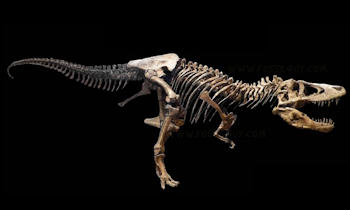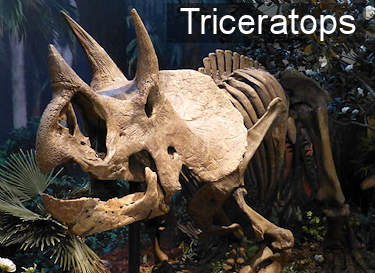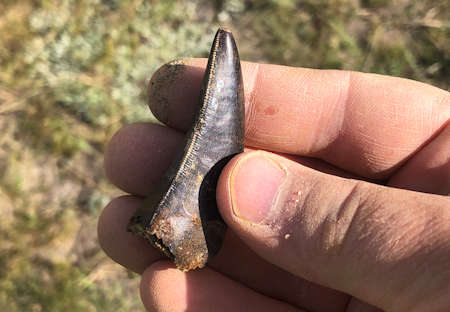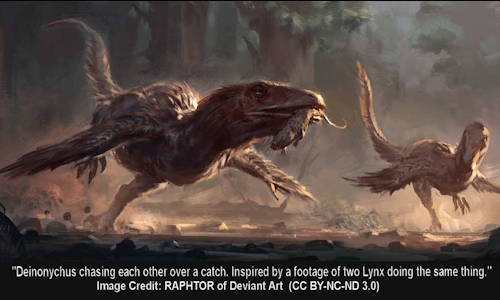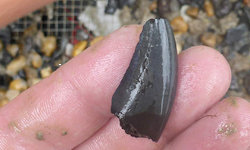Article written by: Jayson Kowinsky - Fossilguy.com
Edmontosaurus
Fast Facts about Edmontosaurus
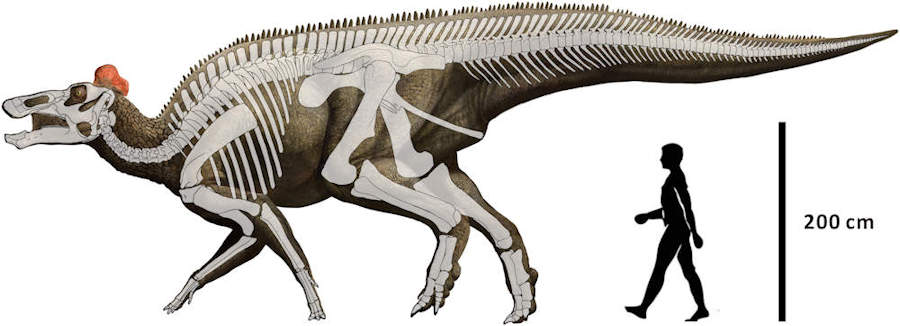
Figure 2 from Xing et al, 2017 - Showing a reconstruction of Edmontosaurus regalis. Notice the dorsal frills and fleshy head comb.
Name:
Edmontosaurus (pronunciation: "ed-MON-tuh-SAWR-us")
The name means "Lizard of Edmonton" - named after the location it was found at.
Taxonomy:
Dinosauria (Dinosaur) - Ornithischia (Bird Hipped) - Ornithopoda (Bird Footed) - Hadrosauridae (Hadrosaur) - Saurolophinae (Solid Crested Hadrosaur) - Edmontosaurus (Genus) - E. regalis and E. annectens (species)
Age: Late Cretaceous
Edmontosaurus dinosaurs lived at the end of the Cretaceous time period, from around 72 to 65 million years ago.
Extinction: End Cretaceous
Edmontosaurus annectens was one of the last dinosaurs to ever exist. It went extinct at the end Cretaceous mass extinction event, which brought a close to the age of Dinosaurs.
Discovery: Lamb, 1917
Edmontosaurus was discovered by Lawrence Lambe in 1917. He named it the "Edmonton Lizard" based on a partial specimen (NMC 2288) from the Horseshoe Cannon formation of the Edmonton group near Drumheller, Alberta.
Distribution: Western North America (Laramidia):
Edmontosaurus lived on the island continent called "Laramidia". This continent is
present day Western North America. Similar Hadrosaurs also lived in Asia, Europe, and Eastern North America.
Body Size: Large: over 13 meters (40 feet)!
Edmontosaurus was one of the largest dinosaurs of its time. Two large speimens, MOR 1609 and MOR 1142 were probably
over 15 meters (49 feet) in length!
Diet: Herbivore
Edmontosaurus teeth and beak were uniquely adapted to mashing up tough plant material, such as conifer needles and bark, horsetail, and angiosperms of the time.
Prey: T-rex
Fossil Evidence shows Tyrannosaurus rex hunted and ate Edmontosaurus. Bones show evidence of being eaten by T-rex, and
even healed wounds from T-rex have been found on Edmontosaurus specimens.
Bipedal:
Although Edmontosaurus could walk on all fours, tracksites indicate it preferred to travel on its hind legs only.
Speed: Fast: 28 mph
Recent studies indicate Edmontosaurus could run in bursts up to 28 mph, which is faster than a T-rex!
Skin: Tough Skin!
The numerous preserved skin and scale patterns show Edmontosaurus had very thick and tough skin!
No dinosaurs in this clade show any evidence of feathers.
Fun Facts:
This is the first dinosaur to show evidence of a soft tissue rooster like comb on its head!
Although some hadrosaurs show a spotted pattern, Edmontosaurus skin impressions show it was probably at least partially striped.
Due to their thick skin, most of the fossilized "Dinosaur Mummies" are from Edmontosaurus.
Intro / Overview of Edmontosaurus
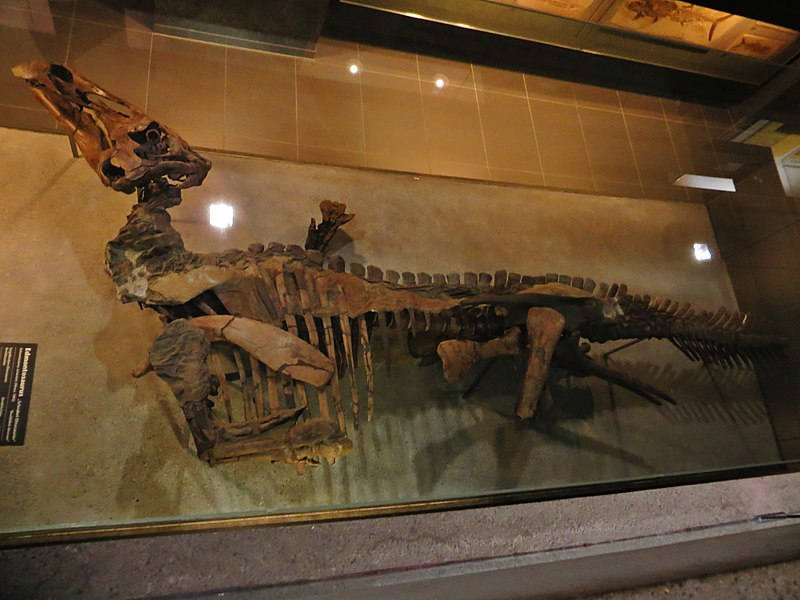
The Senckenberg mummy (SM 4036) from the Senckenberg Museum in Frankfurt. Image credit: Ghedogehdo (C.C.by 4.0).
Due to the presence of large Edmontosaur bone beds and numerous fossils preserving soft tissue and skin impressions, Edmontosaurus is one of the best studied dinosaurs of North America. Famous bone beds containing thousands of Edmontosaurus bones include the Danek Bone Bed in Alberta and the Ruth Mason Quarry in South Dakota. Edmontosaurus fossils that preserve soft tissue include the so called "dinosaur mummies" like the famous Trachodon mummy (AMNH 5060) and the Senckenberg Museum mummy (SM 4036).
From these exceptional specimens and bone beds, paleontologists have pieced together a clear picture of this dinosaur. Gone now is the view of a slow moving, web-footed, duck-billed, swamp inhabiting animal. Today the view of these animals are completely different. Everything from their color patterns, beaks, frills, and rooster-like combs, to their diets, fast running speed, herding and nesting behavior have been revealed.
Edmontosaurus was one of the largest and most common dinosaurs of late Cretaceous North America. It is classified as a hadrosaur, or duck-billed dinosaur. It belongs to the flat-skulled, or solid crested Hadrosaurinae clade, which replaced the older hollow-crested hadrosaurs that had distinct ornate bony ornamentation on their heads.
Name
The name Edmontosaurus comes from Lawrence Lambe in 1917. He named it the "Edmonton Lizard" based on a partial specimen (NMC 2288) from the Horseshoe Cannon formation of the Edmonton group near Drumheller, Alberta.
Species of Edmontosaurs
In the past, numerous species and genera based on slight differences in skulls were erected. However, due to newer and extensive research by paleontologists which demonstrated skull shape changes as a part of the aging process, Edmontosaurs are now divided into two species, E. annectens and E. regalis (Xing et al, 2017; Campione and Evans 2011).
E. regalis vs. E. annectens
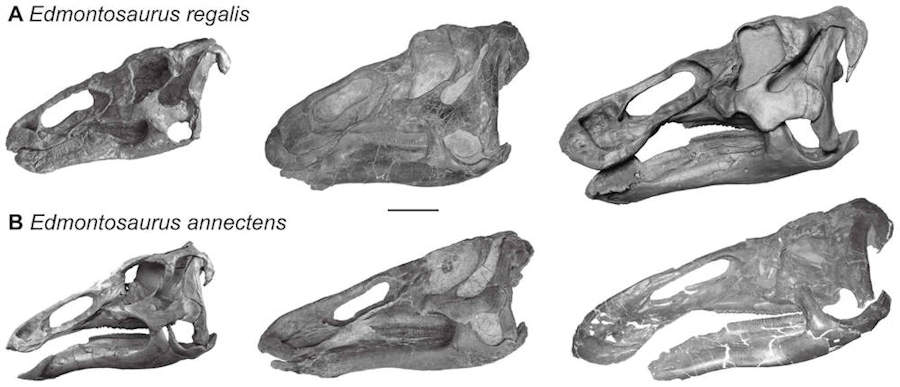
This is from figure 1 of Campione and Evans, 2011 showing Edmontosaurus grown series for both E. regalis and E. annectens.
E. regalis is an older species mainly found in the Horseshoe Canyon and Wapiti Formations of Alberta. These formations are from the late Campanian stage from approximately 72 - 71 million years ago. E. regalis has a shorter, but more robust looking skull, and is generally a larger animal.
E annectens, the younger species, is found in late Maastrichian formations throughout western North America which are approximately 66 to 68 million years old. Famous formations that contain specimens include the Lance, Hell Creek, Laramie, and the Frenchman Formations. E. annectens has a longer and more slender looking skull and is generally a smaller animal than E. regalis.
Edmontosaurs were large dinosaurs. Although E. regalis is generally larger, both species were among the largest of the hadrosaurs and both could reach sizes of over 13 meters (43 feet). Two of the largest specimens, an oversized maxilla called Becky's Giant (MOR 1609) and a huge tail called X-rex (MOR 1142), if complete, would be around 15 meters in length!
The Polar Species
There has been some recent debate on the classification of a polar hadrosaur found in northern Alaska. A short discussion on the latest research is warranted.
Mori et al., (2016) states the Prince Creek Formation of Northern Alaska, which was the northern tip of Laramidia, "preserves one of the most diverse and prolific assemblages of polar dinosaurs known anywhere in the world." Included in the dinosaur taxa is a polar hadrosaur. The hadrosaurs consist of thousands of disarticulated bones of juvenile individuals, so assigning a genus and species has been problematic. Mori et al. conducted a comparative anatomical analysis of skull material from 393 Alaskan specimens. They concluded the hadrosaur, although similar to Edmontosaurus, is not the same and created a new genus and species - Ugrunaaluk kuukpikensis.
However, many studies since have shown this polar dinosaur belongs to the Edmontosaurus genus. Xing et al. tentatively proposed this hadrosaur represents a juvenile form of E. regalis (2014). Later, a more comprehensive anatomical study also showed the polar hadrosaur should be conservatively assigned to Edmontosaurus sp. (Xing et al, 2017). Finally, a cranial study and showed these hadrosaurs were also Edmontosaurus (Takasaki et al, 2020).
A microstructure bone study of these hadrosaurs support they lived in the Polar Regions year round (Chinsamy et al, 2012). What this means is Edmontosaurus had a HUGE range throughout Laramidia and was a highly successful dinosaur.
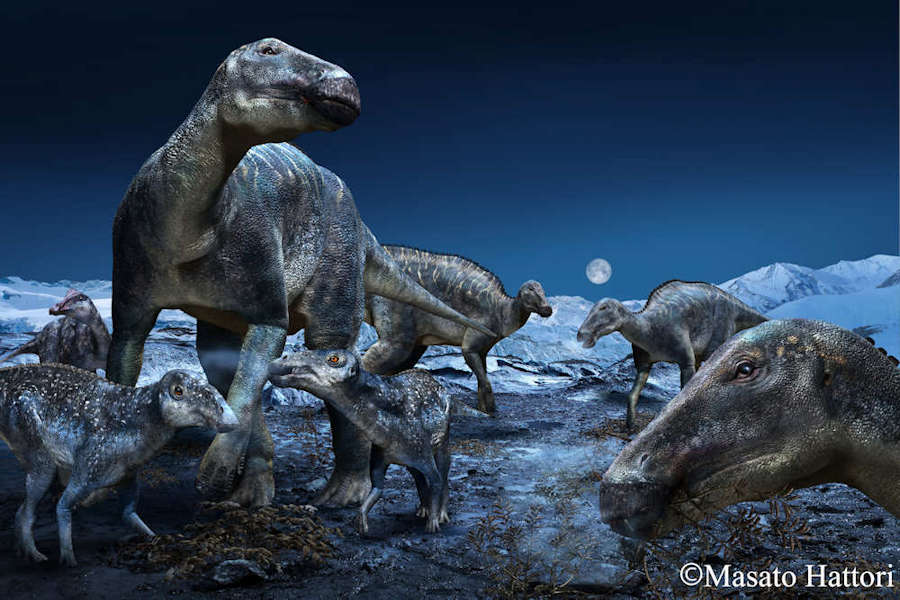
Image of the Polar Hadrosaurs in Alaska now known to be Edmontosaurus. Image Credit: Mataso Hattori for the press release of Takasaki et al, 2020 from the Perot Museum of Nature and Science.
Physical Appearance
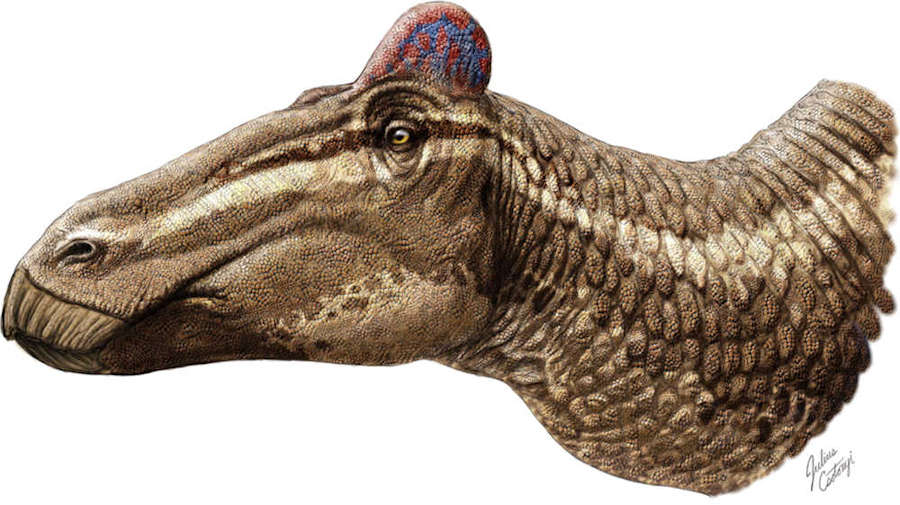
Diagram from Bell et al, 2014 (Figure 4) showing a life reconstruction of Edmontosaurus regalis showing the soft tissue comb structure. Also notice the accurate beak and scale patterns on the illustration. Drawn by J. Csotonyi.
Because of the numerous skin impressions and soft tissue fossils of Edmontosaurs, paleontologists know a great deal about their physical appearance. The following characteristics demonstrate the amazing details we know.
Rooster Like Comb
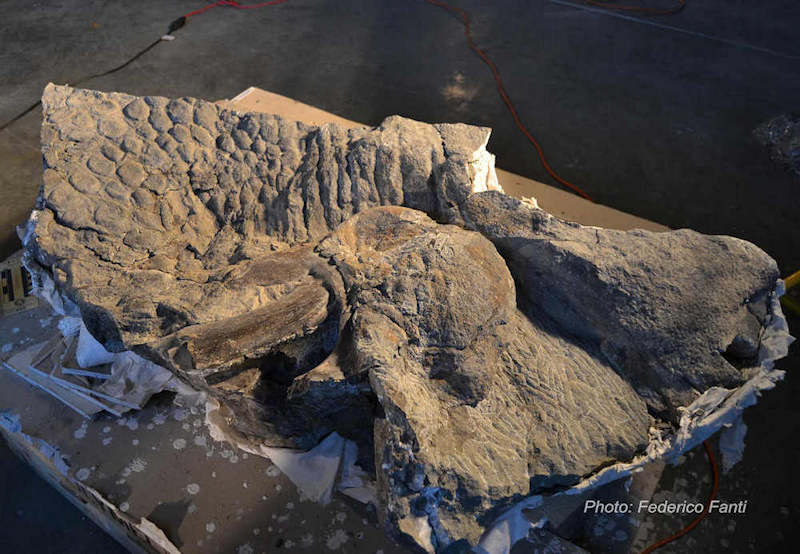
Specimen UALVP 53722 at the University of Alberta showing soft tissue preservation, including the bulbous comb. Image Credit Frederico Fanti University of Albert.
One of the more remarkable traits is the discovery of a fleshy rooster-like comb on the top of its head. This is the first time an entirely soft tissue structure on the head of a dinosaur has been found. It comes from an adult E. regalis specimen called UALVP 53722 from the Wapiti formation in Alberta. This specimen is in the form of a large chunk of sandstone and was studied by Bell et al. in 2014. The very end of the skull is preserved with a handful of vertebra. It is in a "death pose" where the head is bent onto the back of the dinosaur. The bones are covered in three dimensional impressions of skin, scales, and a fleshy dome on the top of the head.
Bell et al. rules out many uses for this soft tissue comb and concludes the comb is most likely used the same way modern birds use their combs, for social signaling and/or sexual selection. The implications are important, as it could mean other dinosaur clades in addition to hadrosaurs could have had fleshy combs or other similar soft tissue structures (Bell et al, 2014).
A Highly Specialized Mouth and Beak
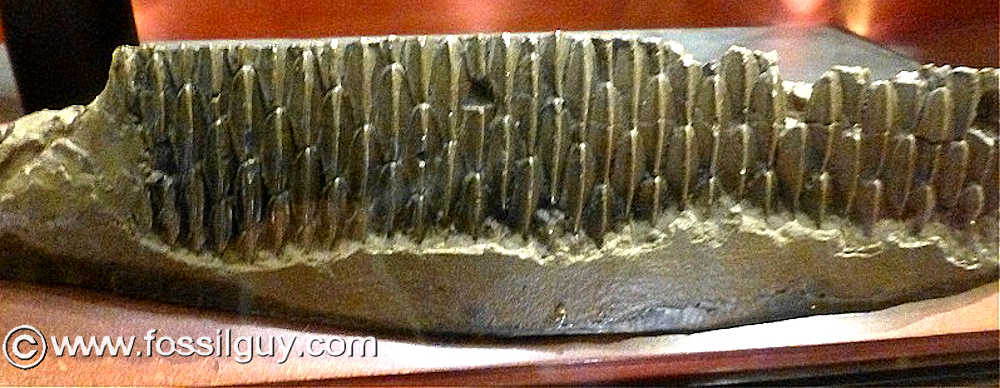
A dental battery from an Edmontosaurus. Specimen on display at the British Museum of Natural History
Edmontosaurus and many other hadrosaurs had a highly specialized mouth, unique structures from their individual teeth, dental batteries, and odd shaped beaks made them highly efficient feeders.
Edmontosaurus and other hadrosaurs have over 1000 teeth that form large dental batteries. The dental battery has rows of teeth with a column of replacement teeth under each row. The mouth would move in a side to side motion, creating an efficient slicing-grinding system (Erickson et al, 2012). In 2012, Erickson et al. did a detailed analysis of Edmontosaurus teeth, looking at types of enamel, microstructure, tooth wear, and tooth replacement patterns. They found that Edmontosaurus teeth were incredibly complicated, and among the most complex of any animal, including mammalian herbivores (Erickson et al, 2012).
Two interesting adaptations were found. First, each tooth had up to 6 types of dental tissue, while most other dinosaurs had 2 types and mammals have 4. Second, they found that dental tissue distribution varies substantially between each tooth position, meaning even each individual tooth was highly specialized! These unique dental batteries were ideal for quickly grinding up very tough plant material, such as conifers' needles and woody parts, angiosperms, and horsetail, all found in their stomach contents. Paleontologists have even discovered they ate chunks of rotting conifer wood full of crustaceans, presumably for extra protein (Chin et al., 2017).
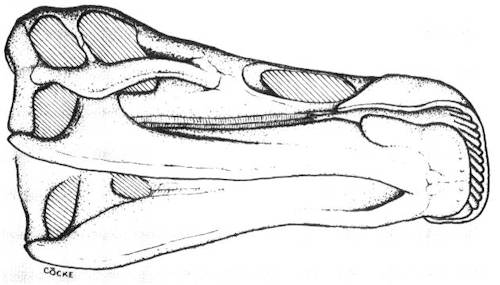
Restoration diagram of the specimen LACM 23502 showing the reconstructed bill. The view is from the bottom of the mandibles. From Morris, 1970 (Figure 2).
Besides the unique dental battery, Edmontosaurs had another peculiar adaptation, a beak. No animals have today have a similar beak and this beak changes the appearance of the dinosaur. The wide flat duck bill-like appearance would be unrecognizable with the addition of this beak.
Most of the beak-like structures that were reported from Edmontosaurus and similar hadrosaurs in the late 18th and early 19th centuries have either been lost or destroyed. Fortunately, in the late 1960's, an Anatosaurus skull (now considered Edmontosaurus) called LACM 23502 was found with a well preserved internal cast of a keratinous beak. This specimen was studied in detail by Morris in 1970. The beak in the upper jaw curves vertically downward over the beak of the lower jaw. Morris believed the beak was used to strain out aquatic vegetation from water, but today most paleontologists think it was probably used to shear off tough vegetation and bark that would then be grinded up with the highly specialized dental battery.
Skin and Color Patterns
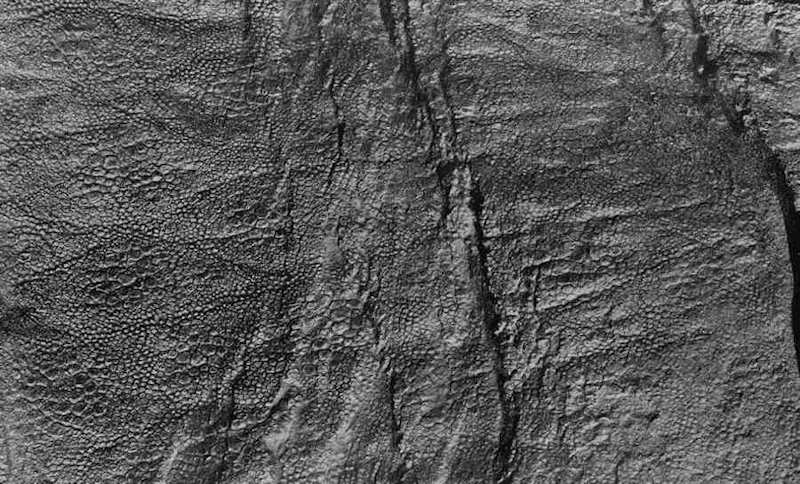
Skin from the famous Trachodon mummy (AMNH 5060), showing different patterns and sizes of scale. From Osborn, 1912 (Plate 7).
Thick Skin
Edmontosaurus and other hadrosaurs had very thick skin. It was thought the abnormal abundance of skin impressions and "mummies" were due to the fact that the dinosaurs were extremely common and/or they spent most of their time near water. However, Davis tackled these ideas in 2012. He wanted to know why hadrosaur fossils are 31 times more likely to have skin preserved than other dinosaurs (Davis, 2012). He found ceratopsians doubled the number of hadrosaurs, but their skin is rarely preserved. Also, hadrosaur skin has been found in a variety of paleoenvironments, not just river valleys. So if hadrosaur skin is not preserved because they are more common or more of them lived near water, Davis suggests the skin simply may have been tougher. This makes sense, as hadrosaurs, especially Edmontosaurus, was on the Tyrannosaur menu; the extra thick skin would aid in survival during Tyrannosaur attacks.
Segmented Frill
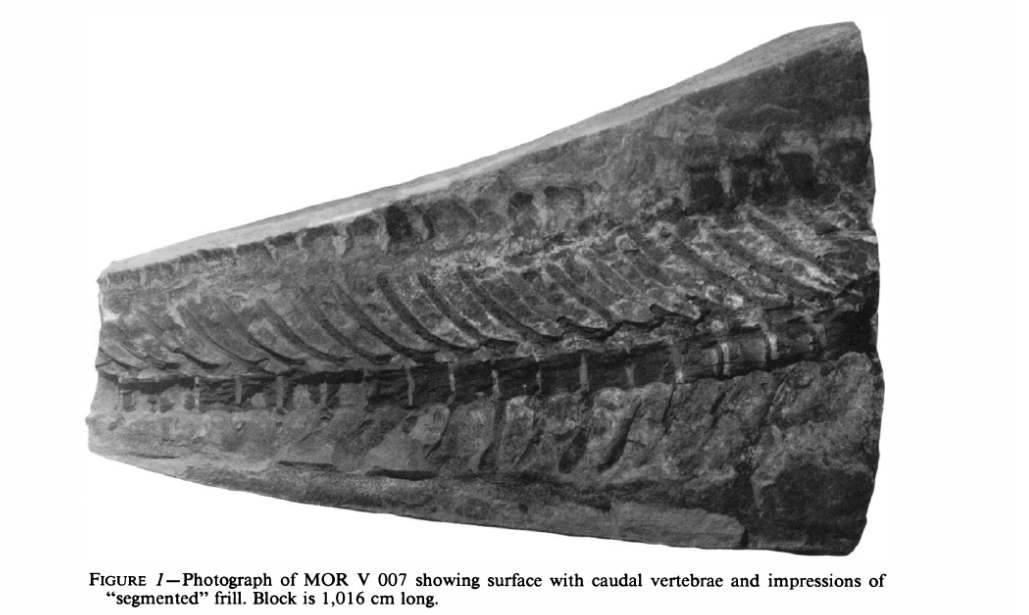
This is figure 1 from Horner, 1984 showing specimen MOR V 007 with the segmented frill running above the vertebra. (They look like black rectangles toward the top of the fossil).
Skin impressions also show the outline of a segmented frill that ran along the tail and possibly other parts of the body. Specimen MOR V 007 studied by Horner in 1983 is part of an Edmontosaurus tail with clearly visible frill segments.
Striped Skin
Although the color of Edmontosaurus cannot yet be determined, scale patterns of modern animals often correspond to color changes. By viewing the scale patterns on Edmontosaurus skin, one can learn what color pattern it may have had. An exceptional specimen nicknamed Dakota was discovered in 1999. Dakota is an Edmontosaurus "mummy" where the soft tissue, including tendons and muscles are still preserved. Although the head and neck are not present, the exquisite skin preservation on the remaining body unveils variations in scale sizes and patterns. According to one of the main researchers, Dr. Manning, the pattern of small and large scales arranged in alternating vertical bars indicate the animal may have had stripes on its tail.
Stripes in modern animals are used for camouflage and to break up and confuse predators when singling out an individual in a herd. So Edmontosaurus' coloration may have allowed it to blend in with its surroundings, or it may have been useful in confusing its predators, mainly Tyrannosaurus.
A Fast Biped
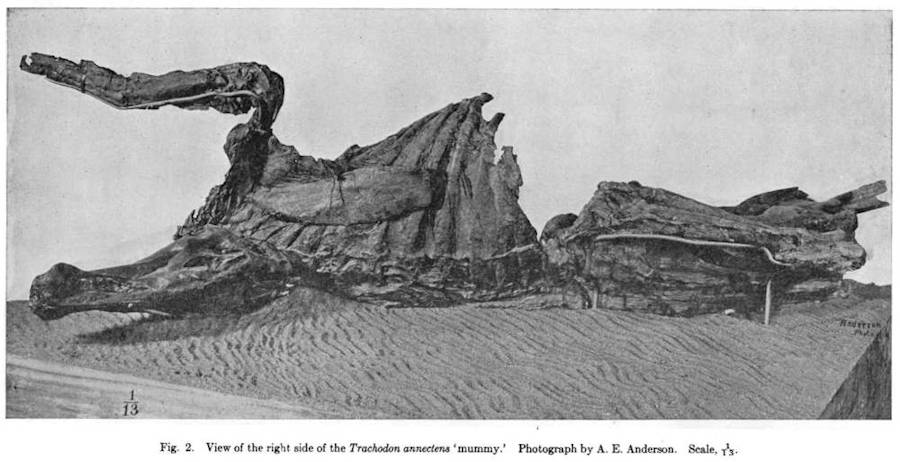
Side view of the Trachodon mummy (AMNH 5060) from Osborn, 1912 (figure 2). The manus (front foot) is covered in a fleshy skin envelope.
Edmontosaurus mummies, including the Dakota mummy, MRF-03, and the Trachodon mummy, show the front feet were covered in fleshy pads, while the back were hoofed. This indicates a bipedal preference. Also, most of the known hadrosaur trackways do not have forelimb prints (Senter 2012). This again shows a preference toward bipedal locomotion. If they preferred to travel on two legs, how fast could they go? The Dakota specimen also provides some great clues as the skin had not collapsed onto the skeleton, meaning the muscle mass could be determined. Manning found the hadrosaurs' legs and tail were 25% larger than originally thought. A calculation of the running speed based on this new muscle mass indicates speeds up to 28 miles per hour, which is faster than a Tyrannosaurus!
Social Behavior - Herding and Nesting
Finally, the frequency and orientation of the numerous hadrosaur track sites are consistent with herding behavior. Track sites from Colorado, Utah, and Wyoming (Carpenter 1992) to Alaska (Mori et al., 2016) all show evidence of herding behavior. There is also ample evidence of group nesting sites, such as the western Montana nesting site studied by Horner in 1982. It appears hadrosaurs, including Edmontosaurus, were very social animals, sticking together in herds and nesting together, similar to many grazing mammals today.
![Hadrosaur tracks from a quarry in southern Italy. These tracks have both the fore and hindfeet. Image Credit: Luca Bellarosa [CC BY-SA 4.0]](Sito_con_orme_di_dinosauri_di_Altamura_(Cretacico_Superiore,_Bari,_Puglia)_Foto_Luca_Bellarosa_.jpg)
Hadrosaur tracks from a quarry in southern Italy. These tracks have both the forelimbs and hindfeet. Image Credit: Luca Bellarosa [CC BY-SA 4.0]
Conclusion
These were some of the largest dinosaurs to exist right up to the mass extinction event. Fortunately, because of their tough skin, Edmontosaurus has left us with a plethora of soft tissue fossils which gives us a unique window into these dinosaurs. We know more about this dinosaur than any other in North America. It's interesting to wonder how much more paleontologists will learn once new specimens are discovered and new research is conducted.
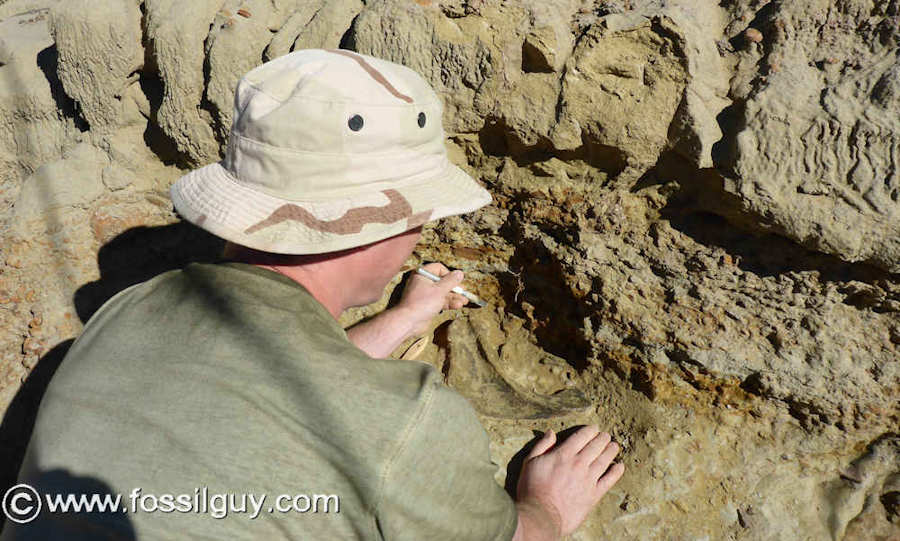
The author excavating a partial Edmontosaurus jaw in the Hell Creek Formation of South Dakota. See the Fossil Trip Here.
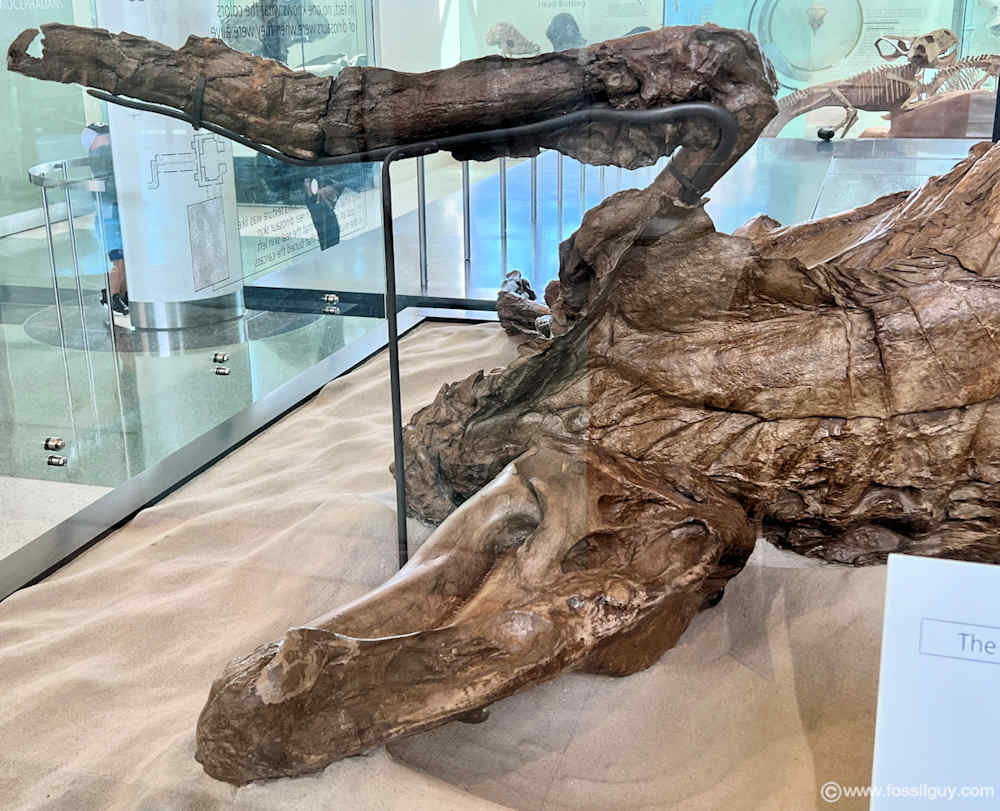
One final image of the amazing "Trachodon Mummy" (AMNH 5060) in New York.
Recommended Dinosaur Books and Educational Items:
References / Works Cited
Bell PR, Fanti F, Currie PJ, Arbour VM. (2014) A mummified duck-billed dinosaur with a soft-tissue cock's comb. Current Biology. 24: 70-75. pmid:24332547. doi.org/10.1016/j.cub.2013.11.008
Campione NE, Evans DC. (2011) Cranial Growth and Variation in Edmontosaurs (Dinosauria: Hadrosauridae): Implications for Latest Cretaceous Megaherbivore Diversity in North America. PLoS ONE. 6(9): e25186. doi.org/10.1371/journal.pone.0025186
Caprenter, K. (1992) Behavior of hadrosaurs as interpreted from footprints in the "Mesaverde" Group (Campanian) of Colorado, Utah, and Wyoming. Contributions to Geology, University of Wyoming. V. 29, P. 81-96 (Link to Paper)
Chin K., Feldmann R., & Tashman, JN. (2017) Consumption of crustaceans by megaherbivorous dinosaurs: Dietary flexibility and dinosaur life history strategies. Scientific Reports. 7. 10.1038/s41598-017-11538-w
Chinsamy, A. Thomas DB, Tumarkin-Deratzian AR, Fiorillo AR. (2012) Hadrosaurs Were Perennial Polar Residents. The Anatomical Record: Advances in Integrative Anatomy and Evolutionary Biology, 295 (4): 610 DOI: 10.1002/ar.22428
Davis, M. Census of dinosaur skin reveals lithology may not be the most important factor in increased preservation of hadrosaurid skin. (2012) Acta Paleontologica Polonica. http://dx.doi.org/10.4202/app.2012.0077
Erickson GM, Krick BA, Hamilton M., Bourne GR, Norell MA, Lilleodden E, Sawyer WG. (2012) Complex Dental Structure and Wear Biomechanics in Hadrosaurid Dinosaurs. Science, 338 (6103): 98 DOI: 10.1126/science.1224495
Horner, JR. (1984) A "segmented" epidermal tail frill in a species of hadrosaurian dinosaur. Journal of Paleontology. 58, 270-271. (Link to Paper)
Mori H, Druckenmiller PS, Erickson GM. (2016) A new Arctic hadrosaurid from the Prince Creek Formation (lower Maastrichtian) of northern Alaska. Acta Palaeontologica Polonica. 61(1): 15-32.
Morris, WJ. (1970) Hadrosaurian dinosaur bills - morphology and function. Los Angeles County Museum, Contributions in Science. 193, 1-14.
Osborn, H.F. (1912) "Integument of the iguanodont dinosaur Trachodon", Memoirs of the AMNH ; new ser., v. 1, pt. 1-2. (Link To Paper)
Senter, P. (2012) Forearm orientation in hadrosauridae (Dinosauria: Ornithopoda) and implications for museum mounts. Palaeontologia Electronica. 15. (Link to Paper)
Takasaki R., Fiorillo A.R., Tykoski R.S., Kobayashi Y. (2020) Re-examination of the cranial osteology of the Arctic Alaskan hadrosaurine with implications for its taxonomic status. PLOS ONE 15(5): e0232410. DOI: 10.1371/journal.pone.0232410.
Xing H, Mallon JC, Currie ML. (2017) Supplementary cranial description of the types of Edmontosaurus regalis (Ornithischia: Hadrosauridae), with comments on the phylogenetics and biogeography of Hadrosaurinae. PLoS ONE. 12(4): e0175253. DOI: 10.1371/journal.pone.0175253.
Xing H, Zhao XJ, Wang KB, Li DJ, CHEN SQ, Mallon JC, et al. (2014) Comparative osteology and phylogenetic relationship of Edmontosaurus and Shantungosaurus(Dinosauria: Hadrosauridae) from the Upper Cretaceous of North America and East Asia. Acta

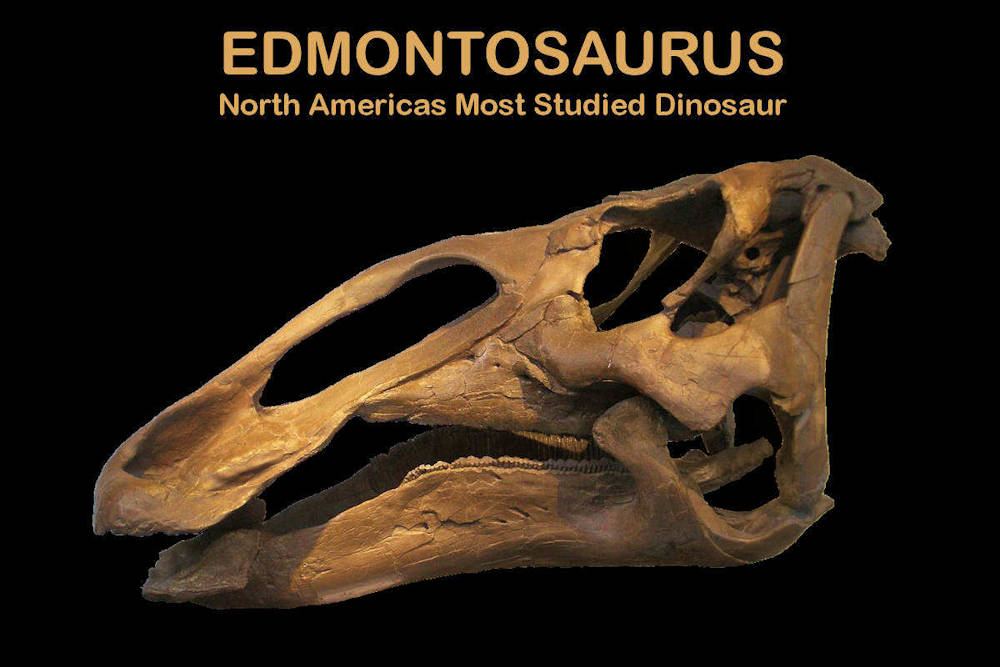





 Paleoadventures Dinosaur Digs
Paleoadventures Dinosaur Digs
